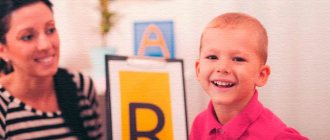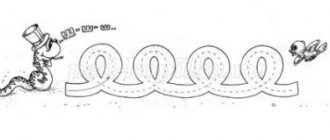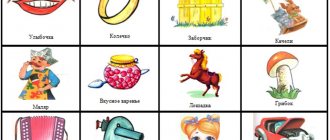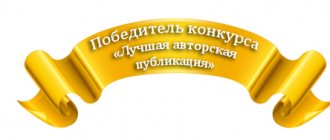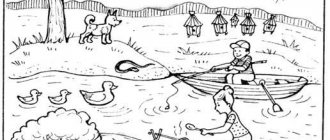Normally, by the age of 3–4 years, children correctly pronounce the hard and soft sound “s”. Incorrect pronunciation is called sigmatism. If you notice that your child has errors in sound pronunciation, do not delay - contact a speech therapist. After all, the sooner a defect is corrected, the easier it is to get rid of it.
In this article we will talk about the types of sigmatism, the features of the correction program and exercises for sound production that you can do with your son or daughter at home.
Forms of sigmatism
Sigmatism is a defect in the pronunciation of hissing and whistling sounds, in our case “s”. There are 4 forms of violation.
The first is sigmatism itself, when “s” is absent from speech.
The second is parasigmatism, that is, when “s” is replaced with another sound.
Variants of parasigmatism:
- on “f” - labiodental;
- on “t” - toothed;
- on "sh" - hissing.
The third is the distortion of the “s” sound. There are several options: interdental (the child has a lisp, instead of “s” you hear “sh”), lateral (instead of “s” you hear “lkh”) and nasal (instead of “s” you hear a grunting or snoring sound, vowels are pronounced in a nasal voice).
The fourth is softening the hard sound “s”. It turns out like this: instead of the syllable “sa” - “sya”, “so” - “syo”, “su” - “syu”, “s” - “sya”.
How to consolidate the results of classes
To achieve the desired result, you should work with a speech therapist on an ongoing basis. It is strongly recommended not to quit classes at the first improvement in pronunciation. Sound fixation is carried out through automation. This process involves the use of individual sounds when pronouncing syllables, phrases and sentences. During classes with a speech therapist, you are given tasks that help improve your speaking skills. The automation stage is considered the most difficult. Activities help develop speaking skills and introduce learned sounds into everyday speech. The main task of parents is to facilitate the process by prompting and helping the child.
The most effective way to consolidate results is to read aloud. At the initial stages, you can pronounce simple tongue twisters. In the future, you need to move on to more voluminous texts. It is important to maintain a conversation with your baby. This not only trains speech, but also develops hearing.
For dysarthria in children, physiotherapy, drug treatment and speech therapy massage are used in combination with exercises. Dysarthria develops in 3-6% of cases. It is accompanied by increased tone and excessive tension in the muscles of the articulatory organs. A specific feature of the disease is the difficulty of overcoming defects. Therefore, the process of speech restoration takes much more time.
Stage 1: preparation. Articulation gymnastics
Tell your baby about the activities, articulation, sounds and structure of the organs with which he pronounces them. After the theory, proceed to articulation gymnastics. It includes several exercises that need to be done in the form of a game.
"Building a fence" . The little student smiles widely so that all the teeth are open and touching each other. He says “and-and-and-and” to himself for 5 -
10 Seconds.
"Tube" . Starting position - as in the first exercise. The baby rounds his lips and pulls them forward. Holds for 10 seconds. After that it relaxes.
Repeat the exercises several times one by one.
"Open and close the fence" . The baby takes the starting position and opens his mouth, places the tongue at the bottom, and rests the tip against the lower teeth. Then he closes his mouth.
"Naughty tongue" . The student opens his mouth slightly and places his relaxed tongue on his lower lip. Spanking, he says: “La-la-la,” then bites with his teeth and says: “Tya-tya-tya.”
"Pancakes" . The baby smiles so as to open the upper teeth, the tongue is motionless and touches the corners of the mouth. Holds for 15 seconds.
“Cool the pancakes . The student smiles, as in the previous exercise. Then he blows, pronouncing the sound “f” for a long time, but without puffing out his cheeks.
"Clean teeth" . The baby opens his mouth slightly and smiles, then moves the tip of his tongue behind his lower teeth to the sides without moving his jaw. You can “clean” the outer and inner surfaces of your teeth.
"Slide" . The student opens his mouth slightly, rests the tip of his tongue on the lower teeth, lifts the back of the tongue, and presses the side surfaces against the upper teeth. Fixes the position for 15 seconds, after which he bites the upper part of the tongue and rolls his teeth down along the tongue, as if on a slide.
"Magic wand" . The baby opens his mouth, smiles and tenses the tip of his tongue. Then he presses it against his lower teeth. The speech therapist or parent places a match or counting stick along the center of the tongue. Then the student clenches his teeth and exhales forcefully. The result will be a drawn-out “s”.
The exercise must be repeated first with a match, then without it.
Pronouncing the sound [S]
- the lips slightly stretch into a smile, except in those cases when the subsequent phonemes are the vowels [O] and [U], which leads to anticipatory rounding of the lips;
- the teeth are either compressed or brought together, leaving only a narrow gap (about 1-2 mm);
- the tip of the tongue rests on the gums of the lower incisors, its back is curved, and the lateral edges are adjacent to the upper molars;
- along the tongue, in its middle, a groove is formed, which at the alveoli opens outwards with a narrow round hole;
- the soft palate is raised and closes the passage of air into the nasal cavity;
- The vocal cords are open and freely allow exhaled air to pass into the pharyngeal and oral cavities. The air stream is narrow, cold, strong.
Stage 2: selecting correction techniques
Correction depends on the shape of the defect. We will talk about universal techniques that can be used for staging in any case. These include imitation, the use of reference sounds and mechanical influence.
Imitation technique
Imitation training is effective for minor defects in sound pronunciation in children. Show your child how to pronounce the hard sound “s” correctly. To do this, sit both in front of the mirror so that he can see both himself and you. Next, give your child the following instructions:
- Open your mouth and smile.
- Spread the tongue, tense its tip and rest it on the lower teeth (incisors).
- Let the “breeze” pass through your tongue. The result should be "c".
Young children absorb information and master skills better through play. Come up with them for your child! For example, you can pump up a bicycle tire, deflate a balloon, blow into a bottle with a narrow neck, or blow like a sea breeze - all these actions are accompanied by the sound "sssssss."
Technique of staging from reference sounds
If the child pronounces other sounds well, you can build on them. In the case of sigmatism, the reference sounds are the soft “s” and the interdental “s”.
We use the soft sound “s”.
First, ask your son or daughter to pronounce the sound “s” and see where the tongue is located at this time - the correction depends on this.
- The tongue is located at the top - it rests on the incisors. You can teach your child the correct pronunciation of sounds. To do this, the adult opens his mouth and says “s”, the baby watches and repeats after him.
- The tongue is located below - rests on the teeth. The child is taught to pronounce “s” from the correct articulatory position - the tip of the tongue is on top.
When the baby has learned this, the skill needs to be finally consolidated. This is facilitated by staging exercises.
We pull the sound . The baby smiles and says “s” for a long time. At this time, he himself or the adult below puts his palm to his mouth. When making sounds, slightly cool air should flow.
Rounding the lips . Continuing to do the exercise and holding his palm to his mouth, the baby rounds his lips and pulls them into a tube, as if to pronounce “y”. An adult can show by example how this is done. The mouth should not be opened wide.
We monitor the air . The main condition is that the air flow must be continuous when performing all actions. Moreover, it gets warmer over time.
We reach a solid “c”. If the baby is unable to pronounce it automatically, the adult explains that the task now is to “warm up” the air in the palm. Then everything will work out.
We say "su" . This is an auxiliary exercise that will help your child achieve the desired hard “c”. We monitor the hot air.
We say a hard “s” . As soon as the result is obtained, show with your example: move your lips forward, as if you are going to say “y-y-y-y”, clench your teeth. This will “affirm” the “s” even more. If the baby presses his tongue tightly against his upper teeth, it will be even easier for him.
We consolidate the result. Introduce the learned sound in syllables with all vowels.
We start from the interdental reference sound “s”
Does the baby stick his tongue between his teeth, pronouncing “s”? Look where exactly the tongue is located:
- There is a “groove” along the tongue; the baby places the tongue between the teeth. Show your child how to hide it behind his teeth and say “s” yourself so that the baby can see;
- There is no “groove”, the tongue is flat. First of all, you need to establish correct interdental sound pronunciation. An adult should not say “c” out loud.
In this case, the following step-by-step production of the sound “s” is used.
Correct articulatory posture . The student needs to spread it out and stick it between his teeth. Move the tip of the tongue forward or position it at the level of the incisors. Then smile widely with closed lips and, ideally, bite the sides of the tongue.
We blow into our palms. The main thing is that the air stream should be as cold as possible. This will create the necessary “groove”. The baby should smile continuously; you can hold the upper lip with your finger - this will make it easier. If he does everything correctly, a whistling sound will be heard.
We whistle like a mosquito . Sit the baby in front of the mirror, show him the “groove” and explain that thanks to it the baby can whistle. But that’s how a big mosquito whistles, and you need to learn to speak like a small one - in a thin voice.
Finally we put “c”:
- The student continuously “whistles.” It is better if he controls this process by looking in the mirror. The main thing is that the “groove” must remain in place.
- Slowly removes the tongue behind the upper incisors and presses it against them from the inside. The adult shows how to do this, but does not say “s”.
- The baby almost achieves the correct sound pronunciation. Then he opens his mouth and the correct pronunciation is heard.
When the student correctly pronounces “s” in isolation, begin to introduce it into speech: first in syllables, then in words.
Mechanical impact
For setting, use counting sticks, blunted toothpicks, matches - any of the listed tools will do.
One of the ways is this. The baby places his wide tongue below, its tip resting on the lower incisors. An adult places a match in the middle of the tongue. After this, the child brings his palm to his mouth, bites the match and smoothly but forcefully blows out air so that he can feel it on the skin of his palm.
If “s” is heard at the same time, it is practiced with a match, and then without it.
Here are a few points to keep in mind when doing the “c” exercise:
First, insert the match into the baby’s mouth 2 cm, and if the tongue dodges, a little deeper.
Secondly, when pressed with a match, the little student begins to whistle with a “lisp.” Ask him to press his lips together so that only the match passes through, but do not let him bite it. The tongue remains in the mouth behind the teeth. The baby blows on the tip of his tongue so that the exhalation passes between the teeth.
Thirdly, control the pressure with the match. Try pressing harder or weaker, deeper or at the very tip of the tongue - this way you will find the position in which your child will get the perfect sound pronunciation.
Fourth, when you place the isolated “s” sound, begin to introduce it into speech. First - into syllables, and then into words. If the baby makes a mistake again when pronouncing the words, connect the match.
Engage with your child in the form of a game: draw analogies with cartoon characters, show pictures, interesting stories.
Stage 3: automation, or consolidation
Mastering correct sound pronunciation in isolation from speech is only the first stage of learning. Next, it is important to consolidate it and bring it to such automatism that the child correctly pronounces the new sound in words and phrases.
First work on the production in syllables, then in words, with “s” at the beginning, middle and end of words. After that, move on to proposals.
Preparatory activities
Before performing exercises aimed at developing conversational speech, breathing training is carried out. She teaches how to blow a stream of air from the lungs. To make the training more interesting for the child, it is recommended to use a small cotton wool or ball.
The most common exercises that develop breathing include the following tasks:
- It is necessary to prepare an empty small bottle. Its neck should be brought to the lower lip. A stream of air is directed into the bubble. If the baby does everything correctly, a characteristic sound appears. This exercise is called “storm”.
- The palms need to be placed on the stomach. Then a deep breath is taken through the nose, after which the breath is held for a couple of seconds. Exit is through the mouth. The purpose of the exercise is to teach the child to control the air stream. The task is called "accordion".
- The “breeze” exercise is performed by stretching out the lips with a tube. A deep breath is taken through the nose. Then a palm is placed to the lips, and a stream of air is released through the mouth.
Staging by imitation
The easiest way to make the sound [C], which parents can use independently in teaching their child. It is better to perform the lesson in front of a mirror, showing the baby how to correctly position the tongue, lips and teeth during pronunciation. And then train [C] in a playful way, offering to demonstrate how the wind blows through a window, or how a tire is inflated, etc. In some cases, only this exercise is sufficient, but often it complements other methods of producing the sound [C].
Development of phonemic processes
L: Now let's play the game "Recognize the sound." There are different objects in front of you: a spoon, a glass, paper. Now I will show you how sound is produced by each object, and you remember this. The speech therapist taps the glass with a spoon, then rustles the paper. - Now close your eyes, I will make sounds, and then you will show me what object I used to make this sound. The speech therapist knocks a spoon on a glass and rustles paper. Plays sounds again so that the child remembers them. R: closes his eyes and then recognizes sounds; if there are mistakes or difficulties, the speech therapist helps.
Development of visuospatial orientation
L: Now let’s go to the table (they get up and go to another table that was prepared in advance). Look at our table. There are various objects on it. There is a bowl to your right, take it and give it to me. R: At first he reaches out to the elephant, but then he takes the bowl and gives it to the speech therapist L: That's right! There is an elephant (toy) to your left, take it and give it to me. R: takes the elephant and gives it to the speech therapist. L: Right! (removes the elephant and the bowl, takes out toy boots and socks). Take the object that lies closer to you and give it to me (the boots are closer). And then take the object that is further from you (further are the socks) R: Takes the socks and gives them to the speech therapist. Afterwards he corrects himself and takes the boots, and then takes the socks and also gives them to the speech therapist. L: Well done!!
Development of visual perception and fine motor skills
L: Let's play a game called "Which picture is missing?" — There are pictures in front of you: Snowman, Sledge, Elephant, Table. - Remember these pictures. When you remember them, “night” will begin and you will close your eyes. - When I say “day”, you will have to open your eyes and say which of the pictures is gone. - “Night” (The speech therapist removes the picture with the snowman). - "Day". Open your eyes. -What picture is missing? - The snowman is missing! (The speech therapist puts the picture of the snowman with the other pictures) - Try to remember all the pictures again: Snowman, Sleigh, Elephant, Table - “Night” (The speech therapist removes the picture with the elephant). - "Day". What picture is missing? - Right! (The speech therapist puts a picture of an elephant with the other pictures). R: Answers, completes the task, if he makes a mistake, the speech therapist helps.
Work on the syllabic structure of a word, sound analysis of syllables
L: Artem, look, I have a picture in my hands, what is drawn in this picture? Our bear Styopa loves sledding. How many syllables are in the word "sleigh"? Say the word “sleigh in syllables.” Get your hands ready, let's try to pronounce this word together: - San (clap) - ki (clap) How many syllables are in the word sani? Two. Now look, there are red, blue and green chips in front of you. Let's put the word Sankey out of these chips. • The red chip is a vowel sound. • The blue chip is a consonant sound. • The green chip is a soft consonant sound. — The first syllable in the word Sanki is San. Lay out this syllable using our chips. R: puts the red chip first, green chip second, blue chip third. L: No. Artem, let's try together to determine what chips the word Sanki consists of. — Explains to the child which chip should go behind which and why. • 1 blue chip, because the sound [s] is a consonant and a hard sound, • 2 red chip, because the sound [a] is a vowel, • 3 blue chip, because the sound [n] is a consonant and a hard sound. L: The second syllable in the word Sanki is Ki. What is the sound [k']? - Well done! What else? R: consonant, hard, voiced! L: Let's say together: - K, K, K! - The sound of K is soft, now put your hand to your throat and say again - K, K, K! - Do you feel the vibration? - So the sound [кь] is what R: k- k- k- k- k. Deaf. L: What color do we designate it with? Since he is agreeable and soft? R: Green! L: Correct, what is the sound? What color do we use to represent it? R: Vowel, red! L: Right, now try to spell out the syllable Ki with chips. R: • 1 chip is green, because the sound [k'] is consonant and soft, • 2 chip is red, because the sound [i] is a vowel. L: Well done, that's right!
Homework
L: Artem, Styopa asks you to cut out beautiful snowflakes from paper at home and decorate the house with them.
Bottom line
L: Today the bear Styopa found a new friend, he really liked playing with you. What sound does Styopa's name begin with? R: From the sound [s]! L: Right! What is the sound [s]? R: consonant, hard, deaf!
Performance evaluation
L: Well done. Styopa really enjoyed playing with you, but it’s time for him to go home to his forest friends. He says goodbye to you. You can go too! R: Goodbye!
Related posts:
- What is "War and Peace" about? Summary of the novel “War and Peace” by chapters. All answers...
- P.P. Ershov “The Little Humpbacked Horse” - summary of “The Little Humpbacked Horse” by P.P. Ershov - a very brief summary for the reader...
- I.S. Turgenev “Mumu” “Mumu” I.S. Turgenev: read the story ONLINE without registration. The work in its entirety...
- What do we know about Morse code? Morse code was created to transmit short information. But use...
Note to parents
The sounds “ts”, “s”, “sh” can be made at home. In this case, responsibility for the outcome of the training falls on the shoulders of the parents. The following principles must be kept in mind:
- The load on the speech apparatus increases gradually. Otherwise, the baby will not be able to learn new information.
- During the exercises, it is recommended to make associations with the world of animals and insects. The sounds “s” and “z” are compared to the squeaking of a mosquito.
- It is necessary to allow the child to independently find a comfortable position for the organs of articulation to reproduce insulating sounds.
- If your child does the exercises without enthusiasm, it is better to stop exercising. This indicates that he is tired.
- Classes must be regular. The optimal frequency is 2-3 times a week. The duration depends on the nature of the baby’s speech deviation.
- When performing mechanical production of sound pronunciation, objects that are not dangerous to the child should be used. It is desirable that this be a special speech therapy probe.
